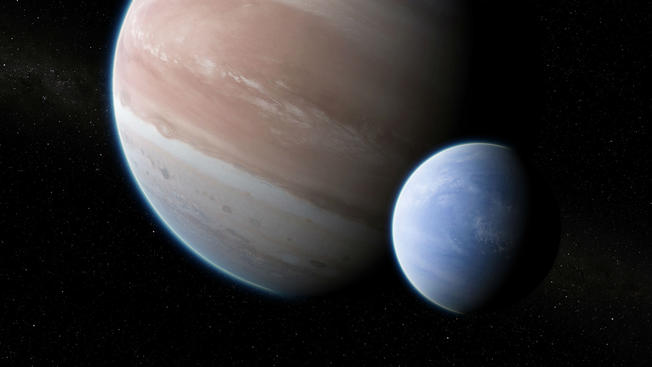
The new discovery of astronomers is called “exomoon” was found from Nasa’s Kepler spacecraft data and observed using the Hubble telescope and it is described as the size of Neptune and orbits a planet the size of Jupiter but with 10 times the mass.
Astronomers David Kipping, from Columbia University in New York and Alex Teachey are reporting and publishing the results Science Advances journal observing all the hypothesis and anomalies, comparing the data they have other planets in the system or stellar activity but they still cannot explain the new discovery.
As astronomers have discovered more than 3,500 exoplanets – worlds orbiting stars other than the Sun a new exploration for exomoons – bodies that orbit these distant planets – has started in parallel. But the results are delayed due to the limits of detection with current techniques. In order to find a suggestive signal of an exomoon, Kipping and Teachey was looking for a heavenly body to pass in front of the parent star`s light and dip and a delay in the planet passing in front of its star. The researchers monitored a 19-hour event when the planet known as Kepler 1625b passed in front of its parent star blocking out some of the light coming from the star, which lies at a distance of 8,000 light-years from Earth and matched with their expectations. In addition, the transit occurred about one-and-a-quarter hours earlier than predicted.
According to Dr Kipping, 3.5 hours after the planet’s transit ended, the Hubble telescope recorded some gravitationally dragging as the a second smaller dimming of the star’s brightness happened again and it was noticed that the apparent moon, known as Kepler 1625b-i, orbits some three million kilometers from the planet.
Still the researchers are trying to claim more data as the discovery requires extraordinary evidence. Both the timing effects and the dimming of the star that we see in the data correspond with the mood model description so the astronomers allocated 40 hours of observation time on the Hubble telescope. These observations ended before a full transit of the moon could be measured but the evidence provided were the most compelling yet for the first known planetary satellite around an exoplanet.
David Kipping has spent about a decade of his career searching for several promising exomoon candidates and the announcement of the new discovery was made in July 2017 by Dr. Kipping along with colleagues Alex Teachey and Allan Schmitt
There are many theories about planetary formation but a recent one suggests that object are unlikely to form themselves in place with their Jupiter-mass planets, but instead they can be captured by the gravity of the planet later on in the evolution of a planetary system.
Agnes is a technical writer, being in touch with reports to come up with the latest tech leaks.






